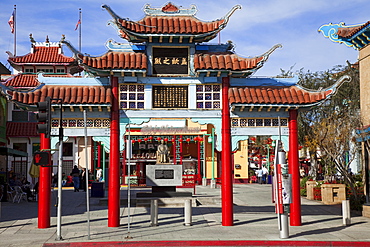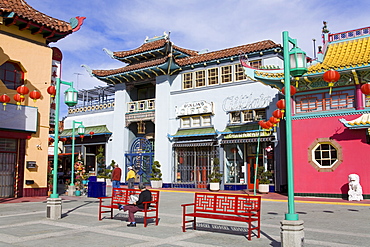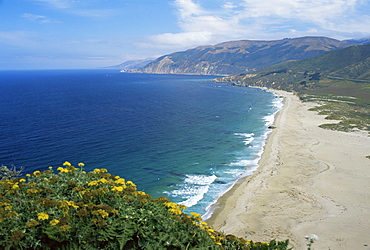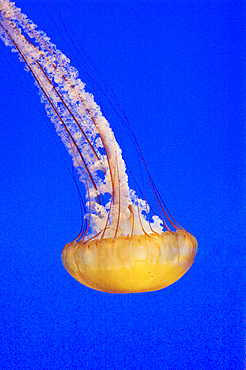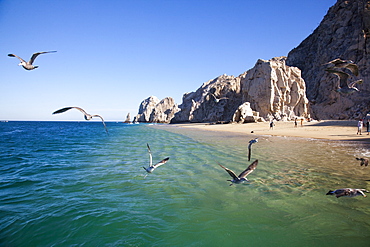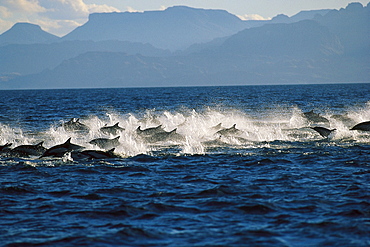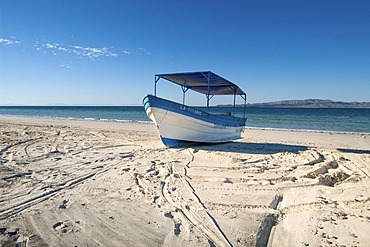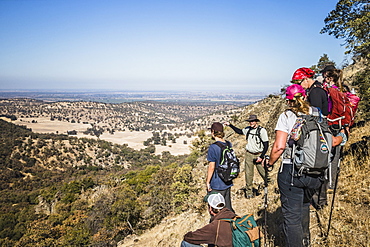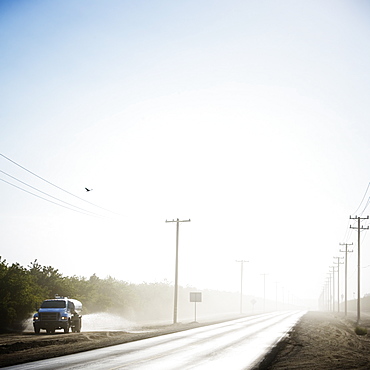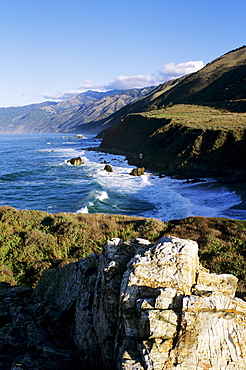Results
17 results found
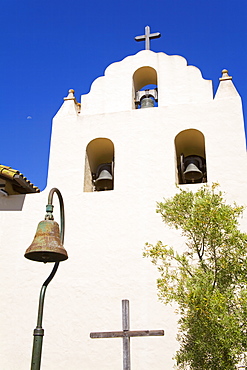
Old Mission Santa Ines, Solvang, Santa Barbara County, Central California, United States of America, North America
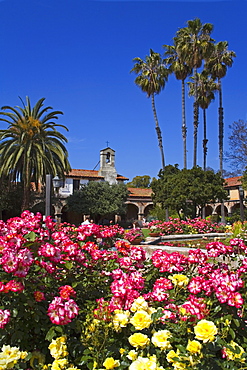
Roses, Central Courtyard, Mission San Juan Capistrano, Orange County, California, United States of America, North America
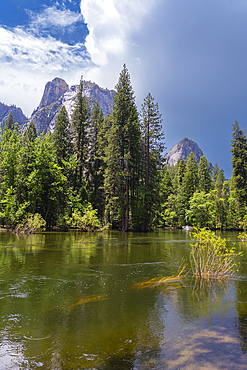
Cathedral Rocks by Merced River, Yosemite National Park, UNESCO World Heritage Site, Sierra Nevada, Central California, California, United States of America, North America

Merced River at Valley View, Yosemite National Park, UNESCO World Heritage Site, Sierra Nevada, Central California, California, United States of America, North America
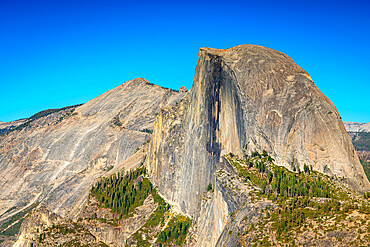
Half Dome granite rock formation, Yosemite National Park, Sierra Nevada, Central California, California, USA
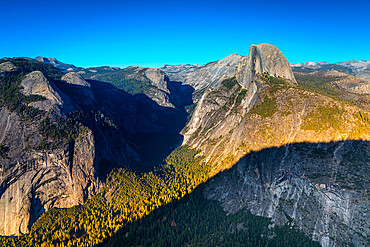
Half Dome granite rock formation, Yosemite National Park, Sierra Nevada, Central California, California, USA

Danish architecture on Alisal Road, Solvang, Santa Barbara County, Central California, United States of America, North America

Alisal Road, Solvang, Santa Barbara County, Central California, United States of America, North America

Restaurant on Alisal Road, Solvang, Santa Barbara County, Central California, United States of America, North America

Windmill on Alisal Road, Solvang, Santa Barbara County, Central California, United States of America, North America

Danish architecture on Alisal Road, Solvang, Santa Barbara County, Central California, United States of America, North America
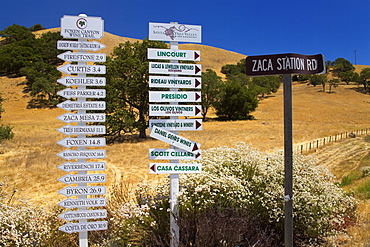
Winery Signs, Santa Ynez Valley, Santa Barbara County, Central California, United States of America, North America

Danish flag, Solvang, Santa Barbara County, Central California, United States of America, North America
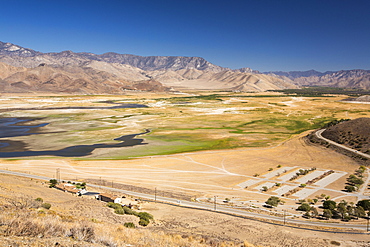
Lake Isabella near Bakersfield, East of California's Central valley is at less than 13% capacity following the four year long devastating drought. The reservoir has dropped so low, that the water level is below the outflow pipe.
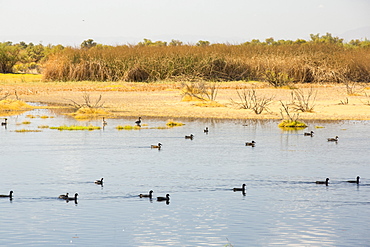
The Kern Valley Wildlife Refuge in California's Central Valley was created as important resting and feeding grounds for wildfowl migrating along the pacific flyway. After four years of unprecedented drought, the water shortages in California are critical. The reserve has received only 40% of its usual warer, with the result that most of the lake beds are dried up and dessicated, leaving the birds few places to go. This is the only area of lake with any water left.
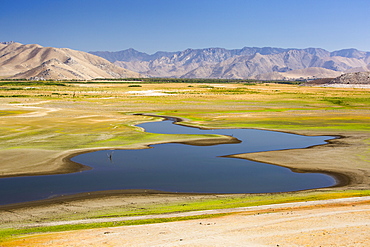
Lake Isabella near Bakersfield, East of California's Central valley is at less than 13% capacity following the four year long devastating drought. The reservoir has dropped so low, that the water level is below the outflow pipe.
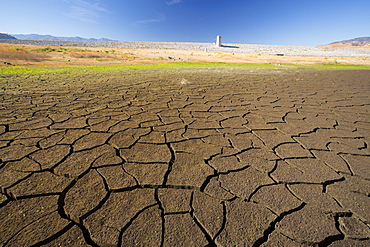
Lake Isabella near Bakersfield, East of California's Central valley is at less than 13% capacity following the four year long devastating drought. The reservoir has dropped so low, that the water level is below the outflow pipe.

Dead and dying Almond trees in Almond groves in Wasco in the Central Valley of California after the irrigation water ran out following the four year long drought in the Western USA. 80% of the world's almonds are grown in California, and it takes 1.1 gallons of water to grow each nut. Many farms have run out of water, and $2.2 Billion has been wiped off the agricultue sector annually. Currently one third of all children in California go to be hungry, as a direct result of job losses connected to the drought. 428,000 acres of farmland have been taken out of production as a result of the drought, in the Central Valley.
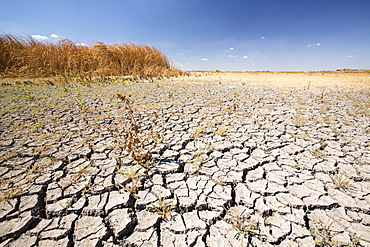
The Kern Valley Wildlife Refuge in California's Central Valley was created as important resting and feeding grounds for wildfowl migrating along the pacific flyway. After four years of unprecedented drought, the water shortages in California are critical. The reserve has received only 40% of its usual warer, with the result that most of the lake beds are dried up and dessicated, leaving the birds nowhere to go.
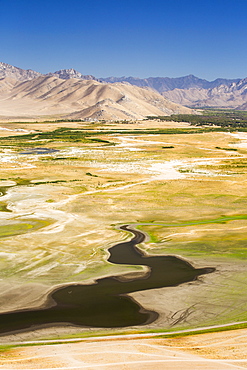
Lake Isabella near Bakersfield, East of California's Central valley is at less than 13% capacity following the four year long devastating drought. The reservoir has dropped so low, that the water level is below the outflow pipe.
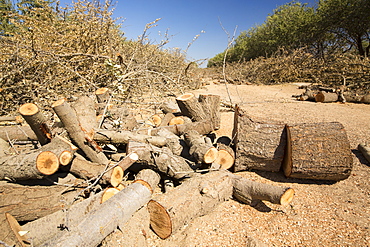
Almond groves being chopped down as there is no longer water available to irrigate them, in Wasco in the Central Valley of California following the four year long drought in the Western USA. 80% of the world's almonds are grown in California, and it takes 1.1 gallons of water to grow each nut. Many farms have run out of water, and $2.2 Billion has been wiped off the agricultue sector annually. Currently one third of all children in California go to be hungry, as a direct result of job losses connected to the drought. 428,000 acres of farmland have been taken out of production as a result of the drought, in the Central Valley.
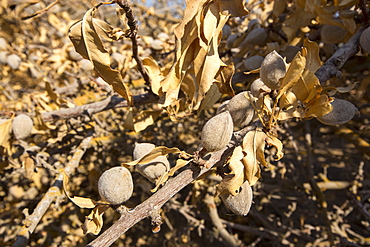
Almond groves being chopped down as there is no longer water available to irrigate them, in Wasco in the Central Valley of California following the four year long drought in the Western USA. 80% of the world's almonds are grown in California, and it takes 1.1 gallons of water to grow each nut. Many farms have run out of water, and $2.2 Billion has been wiped off the agricultue sector annually. Currently one third of all children in California go to be hungry, as a direct result of job losses connected to the drought. 428,000 acres of farmland have been taken out of production as a result of the drought, in the Central Valley.
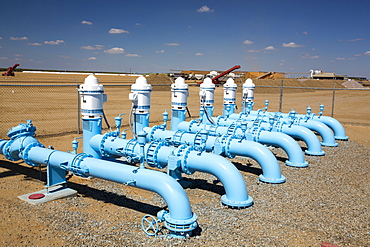
Irrigation pipes near Wasco in the Central Valley of California following the four year long drought in the Western USA. Many farms have run out of water, and $2.2 Billion has been wiped off the agricultue sector annually. Currently one third of all children in California go to be hungry, as a direct result of job losses connected to the drought. 428,000 acres of farmland have been taken out of production as a result of the drought, in the Central Valley.
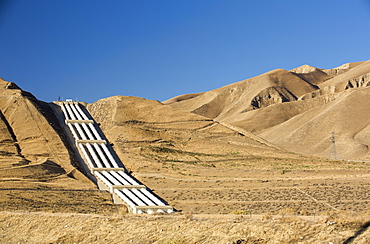
A pumping station sends water uphill over the mountains on the California aquaduct that brings water from snowmelt in the Sierra Nevada mountains to farmland in the Central Valley. Following a four year long catastrophic drought, irrigation water is in short supply, with $2 billion annually wiped off the agricultre sector.
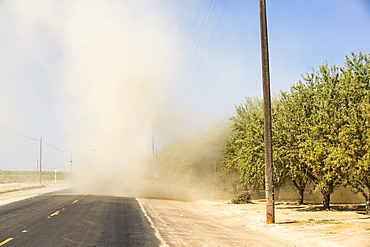
Almond groves in Wasco in the Central Valley of California that are vulnerable following the four year long drought in the Western USA. 80% of the world's almonds are grown in California, and it takes 1.1 gallons of water to grow each nut. Many farms have run out of water, and $2.2 Billion has been wiped off the agricultue sector annually. Currently one third of all children in California go to be hungry, as a direct result of job losses connected to the drought. 428,000 acres of farmland have been taken out of production as a result of the drought, in the Central Valley.

Lake Isabella near Bakersfield, East of California's Central valley is at less than 13% capacity following the four year long devastating drought. The reservoir has dropped so low, that the water level is below the outflow pipe. This shot shows the boat launching jetty, that has been taken as far down the ramp as possible, and is still nowhere near the water level.
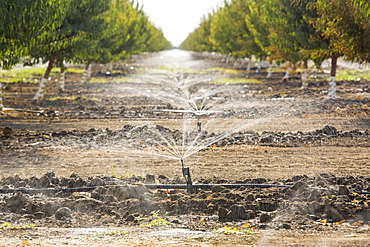
Almod trees being irrigated in California's Central Valley, which is in the grip of a four year long drought. The catastrophic drought means that no crops will grow without increasingly scarce irrigation water. Many areas of farmland have been abandoned due to the drought. 80% of the world's almonds grow in California, each Almond takes 1 gallon of water to produce, water that is increasingly unavailable.
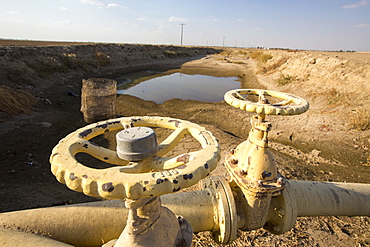
A virtually empty farmers water hole in California's Central Valley, which is in the grip of a four year long drought. The catastrophic drought means that no crops will grow without increasingly scarce irrigation water. Many areas of farmland have been abandoned due to the drought.
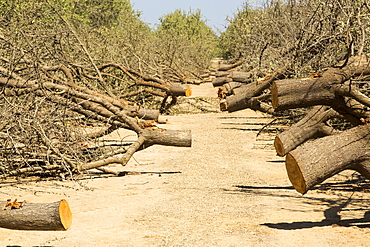
Almond groves being chopped down as there is no longer water available to irrigate them, in Wasco in the Central Valley of California following the four year long drought in the Western USA. 80% of the world's almonds are grown in California, and it takes 1.1 gallons of water to grow each nut. Many farms have run out of water, and $2.2 Billion has been wiped off the agricultue sector annually. Currently one third of all children in California go to be hungry, as a direct result of job losses connected to the drought. 428,000 acres of farmland have been taken out of production as a result of the drought, in the Central Valley.

An RV that until recently would be 40 feet underwater on the lake bed of Lake Isabella near Bakersfield, East of California's Central valley which is at less than 13% capacity following the four year long devastating drought. The reservoir has dropped so low, that the water level is below the outflow pipe.
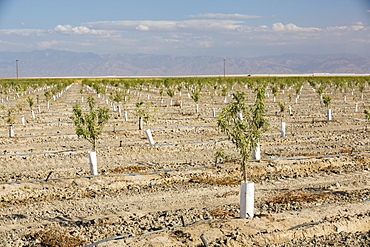
Almond trees being irrigated in California's Central Valley, which is in the grip of a four year long drought. The catastrophic drought means that no crops will grow without increasingly scarce irrigation water. Many areas of farmland have been abandoned due to the drought. 80% of the world's almonds grow in California, each Almond takes 1 gallon of water to produce, water that is increasingly unavailable.
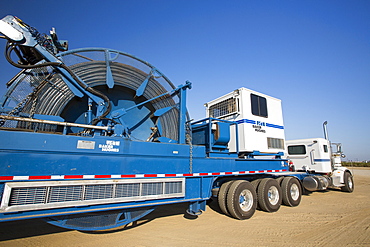
A fracking truck next to a site being fracked near Wasco in California's Central Valley, USA. Fracking for natural gas and oil, has reduced energy prices in the US, but fracking is a water hungry industry, that competes directly with the agricultural sector for water. After a 4 year long drought water is running out. Fracking also contaminates ground water supplies from all the chemicals that are pumped underground to frack the fossil fuel bearing rocks.
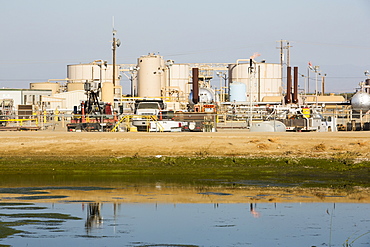
A fracking site being fracked near Wasco in California's Central Valley, USA. Fracking for natural gas and oil, has reduced energy prices in the US, but fracking is a water hungry industry, that competes directly with the agricultural sector for water. After a 4 year long drought water is running out. Fracking also contaminates ground water supplies from all the chemicals that are pumped underground to frack the fossil fuel bearing rocks.

A fracking site being fracked near Wasco in California's Central Valley, USA. Fracking for natural gas and oil, has reduced energy prices in the US, but fracking is a water hungry industry, that competes directly with the agricultural sector for water. After a 4 year long drought water is running out. Fracking also contaminates ground water supplies from all the chemicals that are pumped underground to frack the fossil fuel bearing rocks.

A fracking site being fracked near Wasco in California's Central Valley, USA. Fracking for natural gas and oil, has reduced energy prices in the US, but fracking is a water hungry industry, that competes directly with the agricultural sector for water. After a 4 year long drought water is running out. Fracking also contaminates ground water supplies from all the chemicals that are pumped underground to frack the fossil fuel bearing rocks.
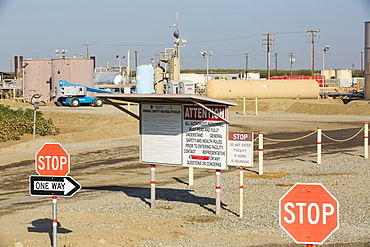
A fracking truck on a site being fracked near Wasco in California's Central Valley, USA. Fracking for natural gas and oil, has reduced energy prices in the US, but fracking is a water hungry industry, that competes directly with the agricultural sector for water. After a 4 year long drought water is running out. Fracking also contaminates ground water supplies from all the chemicals that are pumped underground to frack the fossil fuel bearing rocks.
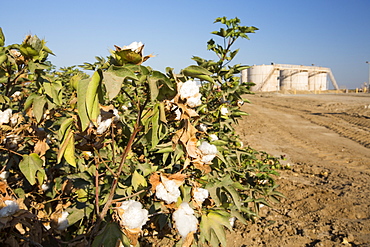
A fracking site being fracked near Wasco in California's Central Valley, USA, next to a farmers Cotton crop. Fracking for natural gas and oil, has reduced energy prices in the US, but fracking is a water hungry industry, that competes directly with the agricultural sector for water. After a 4 year long drought water is running out. Fracking also contaminates ground water supplies from all the chemicals that are pumped underground to frack the fossil fuel bearing rocks.
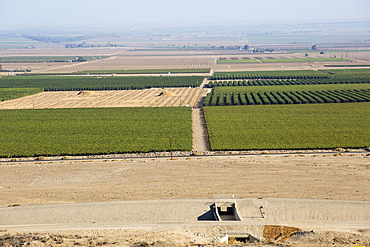
The California aquaduct that brings water from snowmelt in the Sierra Nevada mountains to famrland in the Central Valley. Following a four year long catastrophic drought, irrigation water is in short supply, with $2 billion annually wiped off the agricultre sector.
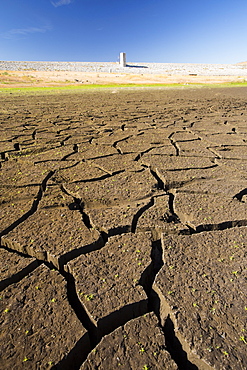
Lake Isabella near Bakersfield, East of California's Central valley is at less than 13% capacity following the four year long devastating drought. The reservoir has dropped so low, that the water level is below the outflow pipe.
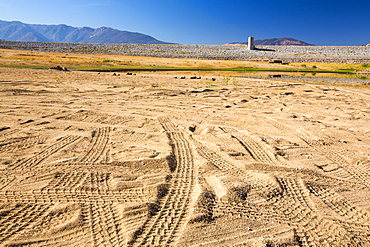
Lake Isabella near Bakersfield, East of California's Central valley is at less than 13% capacity following the four year long devastating drought. The reservoir has dropped so low, that the water level is below the outflow pipe.

The Kern Valley Wildlife Refuge in California's Central Valley was created as important resting and feeding grounds for wildfowl migrating along the pacific flyway. After four years of unprecedented drought, the water shortages in California are critical. The reserve has received only 40% of its usual warer, with the result that most of the lake beds are dried up and dessicated, leaving the birds nowhere to go.
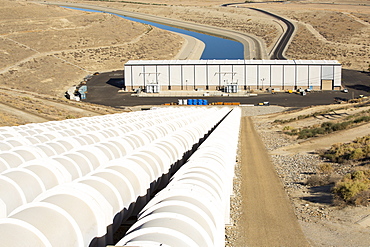
A pumping station sends water uphill over the mountains on the California aquaduct that brings water from snowmelt in the Sierra Nevada mountains to farmland in the Central Valley. Following a four year long catastrophic drought, irrigation water is in short supply, with $2 billion annually wiped off the agricultre sector.

Cotton growing in California's Central Valley, which is in the grip of a four year long drought. The catastrophic drought means that no crops will grow without increasingly scarce irrigation water. Many areas of farmland have been abandoned due to the drought.

Lake Isabella near Bakersfield, East of California's Central valley is at less than 13% capacity following the four year long devastating drought. The reservoir has dropped so low, that the water level is below the outflow pipe, shown here.

The Kern Valley Wildlife Refuge in California's Central Valley was created as important resting and feeding grounds for wildfowl migrating along the pacific flyway. After four years of unprecedented drought, the water shortages in California are critical. The reserve has received only 40% of its usual warer, with the result that most of the lake beds are dried up and dessicated, leaving the birds nowhere to go.
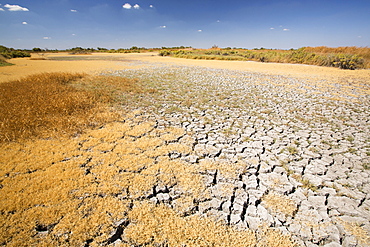
The Kern Valley Wildlife Refuge in California's Central Valley was created as important resting and feeding grounds for wildfowl migrating along the pacific flyway. After four years of unprecedented drought, the water shortages in California are critical. The reserve has received only 40% of its usual warer, with the result that most of the lake beds are dried up and dessicated, leaving the birds nowhere to go.
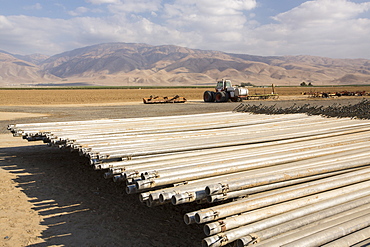
Irrigation pipes in California's Central Valley, which is in the grip of a four year long drought. The catastrophic drought means that no crops will grow without increasingly scarce irrigation water. Many areas of farmland have been abandoned due to the drought.
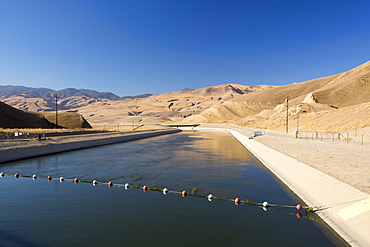
The California aquaduct that brings water from snowmelt in the Sierra Nevada mountains to farmland in the Central Valley. Following a four year long catastrophic drought, irrigation water is in short supply, with $2 billion annually wiped off the agricultre sector.
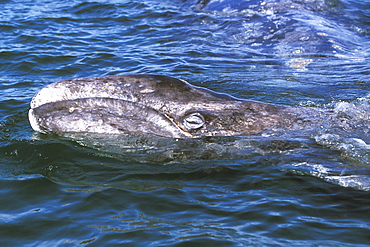
California Gray Whale (Eschrichtius robustus) mother and calf in the calm waters of San Ignacio Lagoon, Baja, Mexico.

Beached California Gray Whale (Eschrichtius robustus) calf with Turkey Buzzards feeding on carcass on Isla Tiburon in the Gulf of California (Sea of Cortez), Mexico.
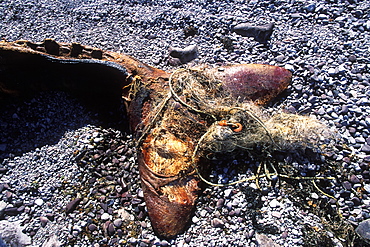
Beached California Gray Whale (Eschrichtius robustus) calf stranded by gill net around flukes on Isla Tiburon in the Gulf of California (Sea of Cortez), Mexico.
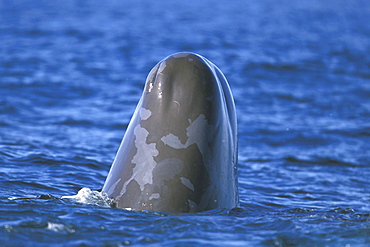
Young Sperm Whale (Physeter macrocephalus) spy-hopping (note the sloughing skin) in the mid-riff region of the Gulf of California (Sea of Cortez), Mexico.

Adult Sperm Whale (Physeter macrocephalus) fluke-up dive at sunset in the mid-riff region of the Gulf of California (Sea of Cortez), Mexico.
(Restricted Resolution - pls contact us)

Sub-adult Sperm Whale (Physeter macrocephalus) surfacing (note the peeling skin) near Isla San Pedro Martir in the midriff region of the Gulf of California (Sea of Cortez), Mexico

Adult Sperm Whale (Physeter macrocephalus) fluke-up dive at sunset in the mid-riff region of the Gulf of California (Sea of Cortez), Mexico.
(Restricted Resolution - pls contact us)
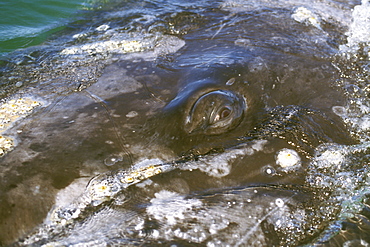
Adult California Gray Whale (Eschrichtius robustus) surfacing (eye detail) in San Ignacio Lagoon, Baja, Mexico.

Sperm Whale (Physeter macrocephalus) surfacing in the mid-riff region of the Gulf of California (Sea of Cortez), Mexico.
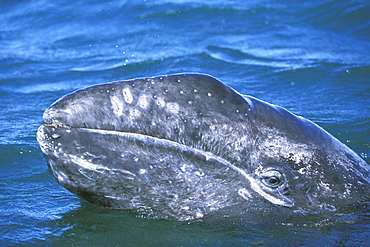
Curious California Gray Whale (Eschrichtius robustus) calf spy-hopping in San Ignacio Lagoon, Baja, Mexico.
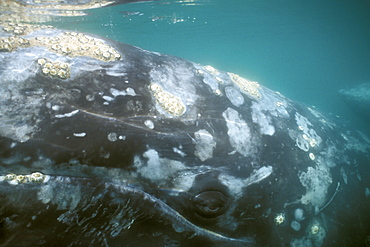
Adult California Gray Whale (Eschrichtius robustus) underwater (eye detail) in the calm waters of San Ignacio Lagoon, Baja, Mexico.
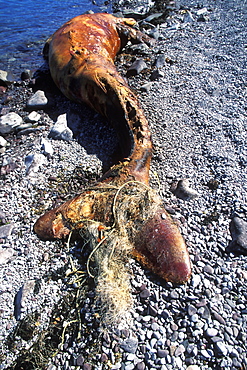
Beached California Gray Whale (Eschrichtius robustus) calf stranded by gill net around flukes on Isla Tiburon in the Gulf of California (Sea of Cortez), Mexico.

Adult Sperm Whale (Physeter macrocephalus) fluke-up dive in the northern Gulf of California (Sea of Cortez), Mexico.
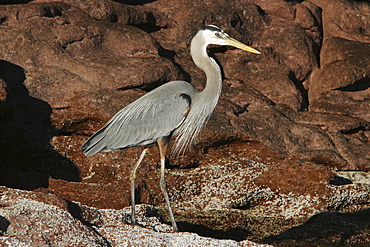
Adult Great Blue Heron (Ardea herodias) in the intertidal zone on Los Islotes in the lower Gulf of California (Sea of Cortez), Mexico.

Viagra in a shell - fresh oysters for sale at fish market on Fisherman's Wharf, Monterey, California.

A view from Bluff trail of waves washing over rock fins at Montaña de Oro State Park, on the central California coast.
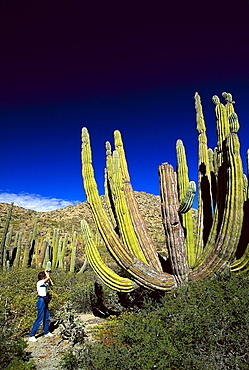
Woman taking a photograph of a giant cactus, Isla Catalan, Baja California Mexico, Central America, America
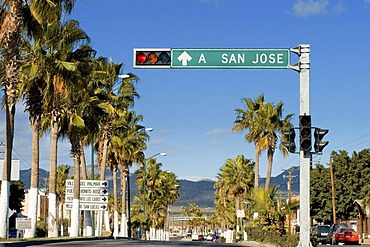
Palm tree-lined road, San Jose del Cabo, Baja California Sur, Baja California, Mexico, Central America
